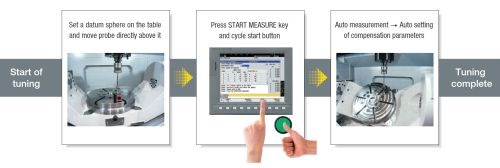5 to 10 for 5
An auto tuning option for Okuma five-axis machines is said to reduce tuning time for geometric errors from five hours to just 10 minutes.
Share




Hwacheon Machinery America, Inc.
Featured Content
View More



Takumi USA
Featured Content
View More


Okuma recently introduced its 5-Axis Auto Tuning System, which replaces the manual tuning process typically used to maintain motion accuracy of CNC machines. As the company points out, manual tuning, a typical practice in many machine shops to compensate for various geometric errors, can take five hours or more to perform. The 5-Axis Auto Tuning System performs measurements and compensation and enables adjustments to be made in 10 minutes, minimizing downtime and enabling higher levels of accuracy, the company says. Auto Tuning is currently available as an option on a variety of new Okuma five-axis machines, including the MU-V series.
During machining, kinematic errors can affect the quality of the finished part. Machines also come out of level over time, and even the smallest bumps can cause geometric errors. When these issues arise, it’s common for machine operators to perform kinematic tuning to compensate for the errors. Done manually, this is a painstaking process involving complex mathematical calculations and manual data entry, and is prone to some degree of human error.
With Okuma’s 5-axis Auto Tuning System these adjustments can be performed in approximately 10 minutes, depending on machine size. In addition to time savings, the 5-axis Auto Tuning System does not require a high level of skill to operate. It measures the machine and automatically compensates up to 13 geometric errors, including volumetric accuracy. This gives the end-user the ability to check and correct the machine whenever necessary, ensuring accuracy and productivity while minimizing downtime.
Auto Tuning is the fourth in Okuma’s “Intelligent Technologies” suite of performance-enhancing functionalities, which includes the Thermo-Friendly concept. Learn more about that in this article.
Related Content
-
Five-Axis Machines Speed NASCAR Engine Production
Moving from an aging set of five-axis mills to more advanced machines enabled Hendrick Motorsports to dramatically improve its engine production.
-
Inverting Turning and Five-Axis Milling at Famar
Automation is only the tip of the iceberg for Famar, which also provides multitasking options for its vertical lathes and horizontal five-axis machine tools.
-
Shoulder Milling Cuts Racing Part's Cycle Time By Over 50%
Pairing a shoulder mill with a five-axis machine has cut costs and cycle times for one of TTI Machine’s parts, enabling it to support a niche racing community.























.png;maxWidth=150)










